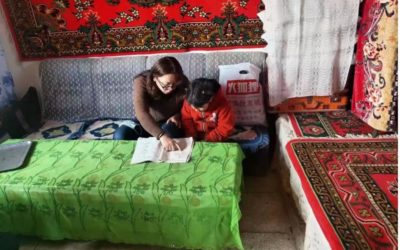Loneliness drives new ‘accompanying economy’
Solo travelers hire “photo companions” for travel pics and conversation
By Gan Chuchu
December 2023

Photo companion Zhou Jiani, right, checks photos with a customer.
A woman smokes a cigarette by the railing of a walkway along Hong Kong’s Victoria Harbour, wearing makeup that stands out because it is not quite the current style – two thin and arched eyebrows, fluttering eyeliner, pale red lips and hair permed in big waves.
Even more unusual for the location, she wears a tight-fitting classical cheongsam dress with large yellow and red peonies embroidered on top of the green fabric, as a photographer continuously snaps pictures of her.
However, this is not a professional modeling shoot. The 45-year-old woman set out on this visit to Hong Kong alone and wanted to take photos that would make her look like an actress in the film by the city’s famous movie director Wong Kar Wai.
“This lady loves to take photos when she travels,” said the photographer, Gong Xiao. “But this time, she was traveling alone, so she came to me.”
Gong’s role is to serve as a “photo companion,” a relatively new job that requires a professional photographer also to have skills as a travel playmate. Also known as “accompanying photography,” the service is in increasing demand from Chinese travelers born after the 1990s or since the turn of the century, many only children raised with little or no peer companionship.
“Most clients are students. Apart from asking me to take photos for them to post on social media, they mainly want to find someone to play with them to ease the fear and discomfort of traveling alone,” said Gong.
According to a survey conducted by China Youth Daily among 1,535 young people aged between 20 and 40, more than 60% of the respondents believed that the rise of what is called “the accompanying economy” was because young people were not well integrated into society and were prone to loneliness. And 80.5% of the respondents found the companionship service helpful.
Gong started working as a part-time photo companion while studying at the City University of Hong Kong. She recalled being surprised when the unique shooting experience, which she mostly did for students, was requested by a middle-aged woman.
Gong said the potential client had immigrated from mainland China to South Korea with her husband, but was unemployed because of language and education issues. The couple had no children and could not relate to peers entering their forties who were mostly busy with families.
“She was lonely inside with many heartfelt matters but had nobody to share,” Gong said. “When she met me, a stranger, she opened up. This was her first trip to Hong Kong, but no one came with her.”
The client and photo companion spent about five hours together on the recent shoot.
“She doesn’t have a high demand for photo quality, but she has a strong desire to express herself. By the end of the day, I had talked to her until my mouth was so dry that I could not say a word,” said Gong with a slight smile.
“The photo companion helped alleviate my fear of traveling alone,” said another photo companion client, 23-year-old Liang Yujie.
Liang said she decided to take a solo trip to China’s Hainan island after graduation last summer.
“But traveling alone can be boring – no one to share my feelings with, no one to help me if I want to take photos at the attractions,” Liang said. “I will panic if I get lost in a strange place,” she added.
Liang contacted a local photo companion through “Xionghongshu,” a lifestyle sharing and purchasing advice platform which means “little red book” in Chinese. She found a three-hour service that cost about 150 yuan (about US$21). On the mainland, the price of accompanying photography is usually lower, between 30 yuan (about US$4.2) and 80 yuan (about US$11.2) per hour, with additional charges for makeup before the shoot and Photoshop enhancement of images later.
Photo companions also play a role as tour guides. Liang’s companion planned out a route for the photo shoots, taking in a variety of scenic spots and even a chance to sample local cuisine.
Liang had a cousin who lived in Hainan, but she said she was too embarrassed to bother her busy relative. A photo companion is a paid service provider, she reasoned, so they could be expected to be more patient and professional. “I can ask for as many photos as possible without feeling like I was bothering my travel companion,” she said.
A study by Wang Jiawei, a professor at the Renmin University of China, showed that the travel companion phenomenon could be linked to research that shows that the lonelier consumers feel, the more likely they are to shop offline. Lonely consumers establish social connections by interacting with service staff, deriving pleasure and satisfaction from interpersonal interactions.
The services are also attracting more providers. Zhou Jiani is a mainland postgraduate student at the Hong Kong University of Science and Technology who has been working part-time as a photo companion since October.
“Accompanying photography can fulfill my interest in photography and also allow me to earn some pocket money, so why not?” So far, Zhou has taken more than 30 orders, with the highest record of four orders a day, when she earned about HK$2,500 (about US$320).

Photo companion Zhou Jiani talks to her client to help her relax. Clients can have social phobias or be socially awkward, some photo companions say.
“At present, most photo companions are part-time college students and photography enthusiasts in their twenties and thirties,” Zhou said. “Because college students have more free time, and their aesthetics can keep up with the trend.”
Zhou said she usually guides her customers, offering verbal advice about poses and often praising them during a shoot. To make herself look more approachable, she often smiles herself to put clients at ease. She said many clients were introverted and shy women who are ashamed of showing themselves in front of the camera.
“But since they come to me to take photos, my responsibility is to make them beautiful and confident,” she said.
Photo companion Zhou Jiani talks to her client to help her relax. Clients can have social phobias or be socially awkward, some photo companions say.
From a communication perspective, accompanying photography is a “weak-tie” relation. “Weak” describes someone who rarely contacts you in daily life. Mark Granovetter, the originator of the weak-tie theory and a professor at Stanford University, stated that weak relationships are more likely to deal with a matter on its merits and share new information and opportunities.
Many photo companions in their posts will describe themselves as a “lively ENFP,” referring to the personality classification characterized by extroversion and friendliness, or say they are “outgoing and love chatting” to attract customers who might be more socially awkward.
But photo companion work can be an unstable career choice, said Xia Xinyi, a Hong Kong Baptist University sophomore who works part-time as a photo companion.
“If there is an epidemic or a bad economy, fewer tourists will come to Hong Kong, and we will be unable to make money,” she said. “Being a photo companion is not a good way to make a living.”
The charges for labor services in Hong Kong are higher than in the mainland, said Xia, who charges HK$90 (about US$11.5) per hour, among the higher rates in the industry. But the hourly wage is still lower than what a tutor might earn.
“While money alone cannot buy a true friend, it is worth spending money for companionship as it helps me feel better,” said Liang.

While money alone cannot buy a true friend, it is worth spending money for companionship as it helps me feel better.

Burned out Chinese teachers struggle with school responsibilities
It’s after 10pm and the city streetlights have long been on in southeastern China. Melisa returns home, exhaustion written on her face. All she wants is a shower
The unseen creators: how AI powers the mini-games becoming online hits in China
In three quick strokes, a blue-haired swordsman unleashes curved, shining blue blades for an attack that appears effortless as it takes down three masked opponents. Moments later, the swordsman stands still with a steely gaze and a calm face.
Facing Death: A young mortician in China
A young mortician in China provides “dignity for the dead and comfort to the living.”





